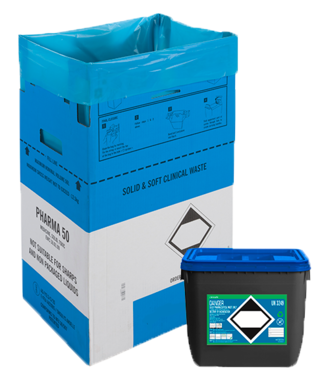
How to Correctly Segregate Clinical Waste

How to Correctly Segregate Clinical Waste

Sustainability is a core focus in the healthcare industry, with the NHS cementing a roadmap to reaching Net Zero emissions by 2045. A key element that increases the collective carbon footprint of the healthcare industry is waste – up to 0.5kg of hazardous waste is creating by each hospital bed per day1.
The correct segregation of waste and ensuring best practice is a key component of this. It allows for the correct disposal, and ensures a more sustainable waste management system by reducing unneeded incineration, and introducing more sustainable treatment options.
Understanding the correct segregation routes is vital to comply with the new updated NHS HTM 07-01, learn what they are below.
Clinical Waste Disposal Colour Streams
Highly Infectious Waste - Yellow
This waste stream is for any item that is known to be contaminated, or suspected to be contaminated with a Category A pathogen such as Ebola, or HIV, including any items that has been contaminated with blood or bodily fluids. This includes any infectious/medical/anatomical waste that requires incineration or alternative treatment. Items including:
- swabs
- bandages
- disposable PPE contaminated with infectious bodily fluids
- IV bags
- chemically-contaminated lab waste
- can be disposed of in this waste system. It is identified with a yellow lid.

Infectious Waste - Orange
Orange containers and bins are designed for both hazardous and non-hazardous infectious waste from known infectious sources such as patients with infectious diseases. This includes:
- infectious dressings
- swabs
- Any anatomical waste or medicines must not be disposed of in this waste stream.

Pharmaceutical Waste - Blue
This waste stream is for the disposal of medicinal waste, including:
- expired medicines (excluding cytotoxic, and cytostatic drugs),
- testing kits,
- contaminated drugs.
This waste stream is identified as a blue cardboard container, or a plastic container with a blue label and blue lid. These products require incineration or specialist treatment methods of disposal.

Cytotoxic and Cytostatic Waste - Purple
Purple lidded containers are for the disposal of chemotherapy drugs and other cytotoxic drugs such as doxorubicin hydrochloride, epirubicin hydrochloride, mitoxantrone.2
These are either a purple cardboard bin, or are a plastic container with a purple lid.

Pathological Waste - Red
Also known as 'anatomical waste', this waste stream is specifically for tissue, organ, or fluid waste, including:
- Amputated tissue
- Full and patrial blood bags
- Blood perserves
This waste stream is identified as a plastic container with a red lid. No sharps should be disposed of in this stream.

Sharps Waste
Sharps waste needs to be segregated into purpose-designed containers that have to be ISO 23907-1 certified. Sharps waste also follows the same colour coded segregation as above and is available in yellow, orange, purple, and blue.

The purpose of the colour coding is to ensure waste management systems comply with legislation like the HTM 07-01.
How can Vernacare help?
Through our Sharpsafe and Clinisafe ranges, we can provide our customers with a complete and fully sustainable clinical waste management system. Offering the world's first full range of sustainable sharps containers and clinical waste containers in both plastic and cardboard, we can help you to create a robust and bespoke system for your healthcare facility.
Contact our team today to discuss how our Sharpsafe and Clinisafe ranges can help you lower your disposal costs, help you comply with legislation, and meet your sustainability goals.

Learn with the Vernacare Academy
Our CPD-accredited course on the Vernacare Academy, 'Clinisafe Waste Segregation Training', outlines all the above that we have discussed and goes into more detail around healthcare waste segregation.
If you're interested in the course, head over to the Vernacare Academy today and sign-up.